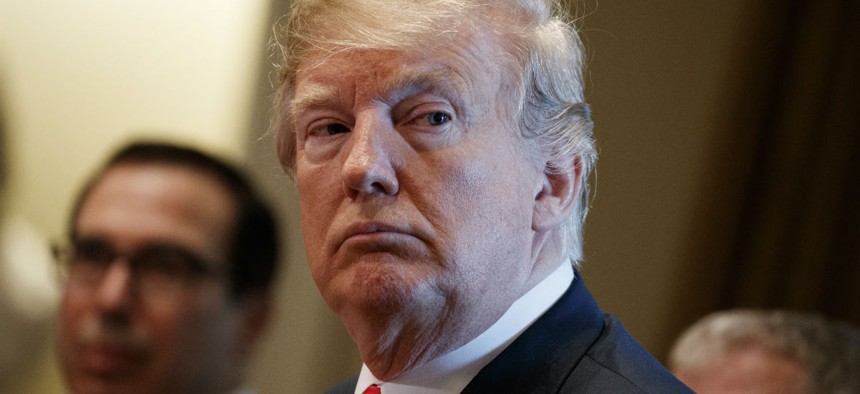
Evan Vucci / AP
White House Proposes a Massive Reorganization of Federal Agencies
The plan, which aims to cut “bloated” bureaucracy, would likely face stiff resistance in Congress.
The Trump administration on Thursday released a blueprint for a massive overhaul of the federal bureaucracy, one that if implemented would touch virtually every agency and the way all Americans receive government services.
“This effort, along with the recent executive orders on federal unions, are the biggest pieces so far of our plan to drain the swamp,” said Office of Management and Budget Director Mick Mulvaney in a statement. “The federal government is bloated, opaque, bureaucratic and inefficient.”
Called “Delivering Government Solutions in the 21st Century,” the proposal contains many far-reaching recommendations, including:
- Privatizing the Postal Service.
- Merging the Education and Labor departments.
- Reorganizing safety-net programs into a Department of Health and Public Welfare.
- Creating a governmentwide public-private partnership office to improve services to citizens, and stewardship of public resources.
- Relocating more staff and offices outside the National Capital Region.
- Dramatically shrinking the Office of Personnel Management.
- Revamping the Army Corps of Engineers.
The plan, led by Mulvaney and based on the agency reorganization proposals he assigned governmentwide in April 2017, is also believed to be influenced by long-standing thinking among conservatives that welfare programs should be funded and managed together.
The notion of creating an Education and the Workforce Department out of the current Education and Labor departments would also deliver on Trump’s campaign promises to focus on jobs for the non-college-bound.
In addition, the plan scales back the Office of Personnel Management. It would move OPM’s security clearance functions fully to the Defense Department, transfer its human services functions to the General Services Administration and locate workforce policymaking at the White House.
Many of these moves would require approval by Congress. Such reorganizational authority was sought by President Obama first in 2012 and again in 2013; he had hoped to merge six agencies—Commerce, the Export-Import Bank and the Small Business Administration among them—into a Department of Business and Trade.
Mulvaney, when asked last year by Government Executive whether he had studied Obama’s plan, said he had not. Instead, the White House appears to be drawing from the playbook of House Republicans in the 1990s when they proposed merging Education and Labor.
Perhaps the most controversial of the proposals would be the reported move of the Supplemental Nutrition Assistance Program, commonly known as food stamps, from Agriculture to Health and Human Services, with the latter department renamed to something that includes the word “welfare.”
Such a switch drew a thumbs-down from Joseph A. Califano Jr., who was President Carter’s Secretary of Health, Education and Welfare before it was renamed HHS when Education became its own department in 1980. “In putting food stamps with Congress’s agriculture committees, we thought they understood the benefits to farm states of the program—financially, to their families and farms—and would be more supportive of it than it would be if the program were viewed as just for poor people,” he told Government Executive last week.
“The farmers would be producing more food for people who weren’t eating nutritional diets. Imagine 40 million people not having enough money to buy food!” added the veteran of the Johnson administration and author of a new book, “Our Damaged Democracy: We the People Must Act.” The anticipated Trump plan, including the rumored proposal to restore the word “welfare” in the departmental name, he said, “is a way of gutting the program—saying, ‘here’s another welfare program.” As the “richest country in the world,” Califano added, “we can afford a food stamp program.”
Robert Shea, a veteran of the George W. Bush Office of Management and Budget and now a principal at the public sector unit of Grant Thornton LLP, told Government Executive the Trump proposals “that require congressional action will be really difficult to accomplish before the end of this Congress, and likely will be made even more difficult after the mid-term elections,” he said. “Those requiring only administrative action will be easier, though Congress has signaled that no such moves should be made without its approval.”
Also skeptical is Max Stier, president and CEO of the nonprofit Partnership for Public Service, which has long studied reorganization of government. “When our government fails to meet citizen expectations, the problems typically stem from people and culture issues, such as shortages in mission-critical talent and the performance and management skills of senior leaders, not how an agency is organized,” Stier said in a statement. “No one can reasonably dispute that our government needs reform, but structural reorganizations are rarely the most effective way to improve service to our citizens.”
Past efforts have often shown disappointing results and require “governmentwide vision,” he added. “The White House also must get congressional buy-in and bipartisan support, make substantial, upfront investments and plan for sustained attention over many years.”







